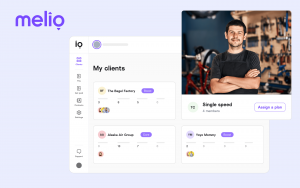How Big Data Helped LiquidPlanner Build Technology Ahead of Its Time [Q&A with Liz Pearce]
![]() I was first introduced to LiquidPlanner at DEMO in 2008, strolling the floor of the banquet hall where dozens of startups had set up booths. LiquidPlanner was one of the handful of companies I remember from the event, and one of the few that’s survived the recession, the mobile revolution and the transition to data-driven business methods. Even as a young journalist at my first tech conference I recognized LiquidPlanner’s potential, and the startup’s foresight into the needs of project management put them ahead of their time.
I was first introduced to LiquidPlanner at DEMO in 2008, strolling the floor of the banquet hall where dozens of startups had set up booths. LiquidPlanner was one of the handful of companies I remember from the event, and one of the few that’s survived the recession, the mobile revolution and the transition to data-driven business methods. Even as a young journalist at my first tech conference I recognized LiquidPlanner’s potential, and the startup’s foresight into the needs of project management put them ahead of their time.
There’s something about project management that forces you to focus on the future, anticipating the needs of an entire team (and beyond) in order to plan for adjustments while still meeting long-term expectations. And LiquidPlanner, even before the big data manifesto took over, understood that data could provide the information needed to better plan for future uncertainties. This dedication to data has granted LiquidPlanner the prowess to navigate a down economy and other pitfalls that catch so many startups off guard. LiquidPlanner is seeing more traction now than ever, which we’ll hear about in today’s CEO Series.
LiquidPlanner CEO Liz Pearce discusses her company’s survival tactics that positioned the project management platform for today’s business needs, the impact data education has on regular employees, and the role of data visualization in their efforts to provide broader access to the data that matters.
![]()
![]()
See the entire CEO Series with Kristen Nicole on Pinterest and Springpad!
.
LiquidPlanner’s technology has been around since 2008, and is seeing greater traction now that data is being more readily applied to project management. How did the LiquidPlanner business survive the early years with a technology ahead of its time?
I actually have great memories of the early years at LiquidPlanner. We were a tiny team rallied around the belief that the whole project management paradigm should be turned on its side. When we were designing the first version of our product, we knew that to be successful, we’d have to shine a light on the fact that there was a simpler way to manage complex projects than the outdated Gantt chart. We were lucky to have a great bunch of early adopters just get it, from day one. Many of them are still with us today.
It was our early customers’ feedback, word of mouth, and loyalty that gave us the runway to continue to improve the product by adding important features like analytics, mobile apps, integrations, and a robust API. We’ve also kept a focus on simplicity, usability, and performance. There’s a huge sense of urgency about getting new features to customers, but we have a high quality bar for what goes out the door. Most people don’t realize that the entire LiquidPlanner team is under 20 folks, with a rock star development team of only six people. We’ve stayed very lean.
LiquidPlanner’s co-founder Charles Seybold, the former CEO, has stayed on with the company as the Chief Product Officer and has had great influence on LiquidPlanner’s design. How has/will this impact LiquidPlanner as a data visualization tool?
![]() From day one, Charles has pushed the envelope on LiquidPlanner’s design, user experience, and functionality. He literally has thousands of screen mockups of LiquidPlanner on his machine. Each new design he shows the team has hours of work behind it. He studies design and usability in his down time and looks at changes to the product from angles most of us would never stop to think about.
From day one, Charles has pushed the envelope on LiquidPlanner’s design, user experience, and functionality. He literally has thousands of screen mockups of LiquidPlanner on his machine. Each new design he shows the team has hours of work behind it. He studies design and usability in his down time and looks at changes to the product from angles most of us would never stop to think about.
For Charles, there’s no good way to present data that’s *not* visual. I can’t remember the last time he handed me a spreadsheet. He speaks about data in images, in charts, and in narratives. Now that he can spend 100% of his time on innovation, I think the experience of using LiquidPlanner will improve for all our customers, and that we’ll continue to be a leader in project data visualization.
In what ways should data empower the end user, the team members responsible for individual tasks that make up a project? Is data-management the new supply chain?
There is certainly democratization of data going on in project management. Information on workload, estimation accuracy, and tracking history has typically only been available to managers. With tools like LiquidPlanner, team members can get a barometric read on their own performance relative to others, not to mention better insight into their own contributions, areas for improvement, and roadmap of responsibility.
Plus, by distributing responsibility for critical team functions, like status updates, project tracking, and schedule changes, executives are getting unprecedented visibility into capacity and their ability to deliver products and services. In this way, it plays a big part in the supply chain for industries that are heavily driven by knowledge workers. You can even see the extension to supply chain analytics, too, since managers get up-to-the-minute visibility into the profitability of the work they’re doing.
When dealing with the uncertainties of project management, what gives you confidence in the future?
Uncertainty is a fact of life for all project managers. If projects were sure things, we wouldn’t need to manage them. That’s why, instead of burying uncertainty, we strive to find better ways to understand it, to communicate it, and to visualize it. This is a huge advantage for our customers, because it de-risks their operations. Seeing them embrace this aspect of planning gives us great hope for the future, because it’s one of the cornerstones of our mission.
I sometimes go back to our archives of previous software releases (we’re now working on our 38th sprint!) to see how we did…how many hours of work we tracked, what features we shipped, how we communicated the changes. I can see a clear evolution in our process through the way we modeled our projects and dealt with the changing nature of our business. A big part of that was learning to address uncertainties early on in each project – now we get better predictions on what we can achieve. I think that’s one of the most exciting developments teams can expect in the next several years – more tools to help them optimize their own performance and deliver better results.
![]()
.
LIZ PEARCE
DATA MAVERICK
Favorite office assistant from TV or Hollywood?
Hands down – Mrs. Landingham from the West Wing. She was one of the most subtly influential people in the President’s life, all from her seat in the secretary’s chair. I’m still mourning her tragic death in a car accident!
Best characteristic of your favorite boss?
His unwavering commitment to keeping the office stocked with coffee. I can’t name names here – there’s always the possibility that he might be poached.
Your optimal time: project ratio?
I like to try to complete writing projects (like blog posts or articles) in a single day. From outline to first draft to review to edits, it’s great to really focus on one thing for eight hours and deliver a piece you’re proud of.
A message from John Furrier, co-founder of SiliconANGLE:
Your vote of support is important to us and it helps us keep the content FREE.
One click below supports our mission to provide free, deep, and relevant content.
Join our community on YouTube
Join the community that includes more than 15,000 #CubeAlumni experts, including Amazon.com CEO Andy Jassy, Dell Technologies founder and CEO Michael Dell, Intel CEO Pat Gelsinger, and many more luminaries and experts.
THANK YOU



















